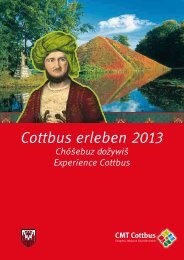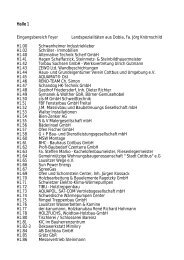Cottbus erleben 2012
Cottbus erleben 2012
Cottbus erleben 2012
Erfolgreiche ePaper selbst erstellen
Machen Sie aus Ihren PDF Publikationen ein blätterbares Flipbook mit unserer einzigartigen Google optimierten e-Paper Software.
1 New town hall<br />
Was built 1934-1936. Reliefs above the pillared<br />
colonnade in Berliner Straße depict symbols of<br />
traditional <strong>Cottbus</strong> craftsmanship (birthplace<br />
of the painter Carl Blechen).<br />
2 Walk of Fame<br />
The path outside the town hall is inlaid with<br />
46 medals, which bear witness to over 100<br />
years of Olympic history in modern times and<br />
honour 31 Olympic and Paralympic medal<br />
winners from <strong>Cottbus</strong>.<br />
3 Medieval city wall<br />
Towers, gates and „Wiek” houses built into the<br />
walls mark the outline of the old town. The Coin<br />
Tower and Spremberg Tower border the 1,200metre-long<br />
section of the old fortifications.<br />
4 Linden Gate<br />
In 1879 a way was cut through the old tower<br />
in Mauerstraße so that the market in the<br />
new town could be reached more quickly<br />
from the old town.<br />
5 Mill island<br />
The Stadtmühle (town mill), whose fate was<br />
finally sealed by its sixth fire in 1882, was<br />
situated directly beneath the castle, the<br />
Schlossberg of today. A man-made trench<br />
was dug out to form an island here. After the<br />
town mill had been gutted by fire, its place<br />
was taken in 1902/03 by the first <strong>Cottbus</strong><br />
electric power station. The intention was<br />
to harness the un used water power of the<br />
burnt-out mill to ge nerate electrical power.<br />
In 1927/28, a diesel power station was built<br />
on the mill island to provide a second<br />
source of electricity.<br />
6 Art Museum <strong>Cottbus</strong> Power Station<br />
Today this old industrial building houses the<br />
diesel power station art museum <strong>Cottbus</strong>. The<br />
attractive, modern clinker building has always<br />
blended in beautifully with the surrounding<br />
park land, where landscaping work began as<br />
far back as 1889.<br />
7 Spremberg Tower<br />
The city’s 31-metre-high landmark was built<br />
in the 13th century and, along with gatehouse<br />
and bas tion, forms the south city gate.<br />
Schinkel designed the battlements, which<br />
were added 1823-25.<br />
8 Spremberger Straße<br />
Characterised by residential and office<br />
buildings constructed in the 19th century<br />
and between 1950 and 1960, this once<br />
leading commer cial route has been given<br />
a complete revamp.<br />
9 Castle Square and Church<br />
This is where four building eras combine.<br />
The house at the eastern end of the square<br />
has been the seat of the mayor, the pastor and<br />
the French judge. To the south is a building in<br />
typical Bauhaus style. First constructed in 1419<br />
and destroy ed by fire several times, after the<br />
arrival of the Huguenots the Katharinenkirche<br />
was rebuilt on its foundation walls in 1714 as<br />
a single-nave rendered structure with a hipped<br />
roof and vestry annex. A neo-Gothic tower was<br />
added in 1870.<br />
10 Wendish Museum/Serbski Muzej<br />
There are 16 exhibition rooms displaying<br />
nume rous costumes, writings, literature,<br />
music, traditional songs, folk heritage, fine<br />
arts and Wendian customs which document<br />
the development of Sorbian culture.<br />
11 Apothecary Museum<br />
Apart from historic pharmacy fixtures and<br />
fittings, attractions in the Löwenapotheke,<br />
a pharmacy over 400 years old, include a fully<br />
equipped dispensary, a collection of tradi -<br />
tional pharmacy items, a herbs and poisons<br />
store and a Galenic laboratory.<br />
12 Old marketplace /market fountain<br />
Once a leading trading centre, originally<br />
surrounded by half-timbered buildings. Today<br />
the marketplace is an impressive ensemble<br />
of Saxon Baroque townhouses and 18/19thcentury<br />
neo-classical eaves-fronted houses.<br />
Dating back to 1991, the market fountain is<br />
octagonally shaped with a central column<br />
along the lines of historical fountains.<br />
13 Oberkirchplatz/Church of St. Nikolai<br />
This was built east of the Altmarkt at the end<br />
of the 19th century following the demolition<br />
of the preacher houses. The biggest church<br />
in Lower Lusatia is a late Gothic three-nave<br />
brick struc ture from the 14th century. The<br />
interior has a beautiful star-ribbed vault,<br />
pulpit and high altar (1664) with<br />
magnificent alabaster carvings.<br />
12<br />
14 Wendish quarter<br />
Was constructed 1984-89 on a historic site<br />
between Berliner Platz and Oberkirchplatz<br />
with building facades typical of the old town.<br />
15 Youth hostel<br />
As part of the city wall the youth hostel at<br />
the Klos tertor borders the Klosterplatz. The<br />
tra ditional two- storey half-timbered building<br />
originally served as a stronghold to protect<br />
the monas tery. It later became an oast-house,<br />
then a warehouse and, in 1842, the site of the<br />
first <strong>Cottbus</strong> textile factory. It has served as<br />
a hostel for walkers since 1936.<br />
16/17 Klosterplatz/Minster<br />
The courtyard and cloister of the medieval<br />
Fran cis can monastery can still be identified<br />
today. Situated amidst beautiful mature<br />
trees between minster and city wall, it is an<br />
idyllic and romantic spot. Also known as the<br />
„Wendish Church”, the minster is part of the<br />
former Franciscan monas tery dating back<br />
to the 13th and 14th centuries. The oldest<br />
building in <strong>Cottbus</strong> conceals an important<br />
piece of the city’s history – the tomb of the<br />
city’s founder and his wife. The crab<br />
depicted on the grave stone remains<br />
the city’s emblem to this day.<br />
18 Puschkinpromenade<br />
Developed into a walk for local citizenry<br />
from the old system of ditches and ramparts<br />
along the city wall in the second half of the<br />
19th century.<br />
19 Conservatoire<br />
Built as a lyceum for the up-and-coming<br />
town in 1911, it became an upper lyceum<br />
in 1928. Its distinct late art nouveau<br />
style is preserved.<br />
20 Coin Tower<br />
This is the city’s oldest tower. It was probably<br />
here that the <strong>Cottbus</strong> city fathers had <strong>Cottbus</strong><br />
„Heller” (coins) embossed with the city’s he -<br />
raldic symbol, the crab, as long ago as 1483.<br />
21 Schlossberg<br />
During the 10th century Wends built a Slavonic<br />
castle rampart on a sand island on the west<br />
bank of the Spree. It is here that the battlements<br />
and neo-Gothic roof of the medieval<br />
castle tower soar 46 metres into the air.





